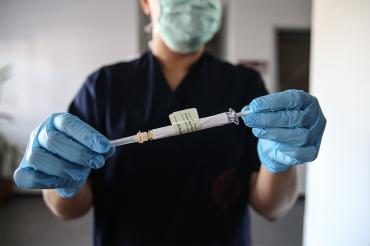Is the end of the pandemic near? U of T expert urges patience following Pfizer vaccine update

Published: November 13, 2020
The aftermath of a bitter U.S. election wasn’t the only big news story this week: One of the groups racing to develop a COVID-19 vaccine – Pfizer BioNTech – said Phase 3 trials suggest its candidate is 90 per cent effective.
The announcement sent the pharmaceutical giant’s stock soaring while the shares of “stay-at-home” companies like Netflix, Amazon and Zoom slumped as investors anticipated an end to the pandemic.
Experts, however, warn there’s still a long way to go.
 “I think there is reason to be hopeful,” says Jeff Kwong, a professor at the University of Toronto’s Dalla Lana School of Public Health and the interim director of the Centre for Vaccine Preventable Diseases.
“I think there is reason to be hopeful,” says Jeff Kwong, a professor at the University of Toronto’s Dalla Lana School of Public Health and the interim director of the Centre for Vaccine Preventable Diseases.
“But there is still a lot of work ahead of us, and we will need to continue doing a lot of what we are currently doing with masks and limited social contact for some time yet.”
Kwong, who is also a family physician with the Toronto Western Family Health Team, is watching COVID-19 developments both as an epidemiologist who studies respiratory viruses and as a doctor seeing his patients.
“There is still work to do,” Kwong stresses. “This vaccine development group and all the others working on vaccine candidates have to finish their Phase 3 trials and then have the results peer-reviewed and published in medical journals. Following that, governments and regulatory bodies will need to approve the vaccines. These are essential steps. After that, we can focus on the distribution and administration of the vaccines.”
Kwong predicts vaccines will begin to be injected into the arms of the global population in the spring or early summer of 2021. The roll out will likely prioritize those who need it most – such as older individuals, hospital staff working in COVID-19 wards and personal support workers caring for residents of long-term care facilities.
There is, however, a potential roadblock on the way to achieving herd immunity: so-called “vaccine hesitancy.”
Kwong says that some people are reluctant to receive a vaccine – any vaccine. That includes so-called “anti-vaxxers,” a small but vocal constituency that Kwong says can probably never be convinced to get a vaccine.
A much bigger group consists of those who are only slightly reluctant.
“This can be for many reasons,” says Kwong. “Sometimes, parents of young children want to wait to vaccinate them until the child is older. Others simply don’t have the time or the means to bring their child for doctors’ appointments. And others may not think a particular illness is serious enough to get a vaccine or they just don’t like getting needles.”
But the biggest reason for hesitancy, Kwong says, is uncertainty surrounding a newly created vaccine, which will be the case for all those approved to protect against COVID-19.
“We are seeing more and more people getting the flu shot every year, but in the early years of giving it, there was reluctance because people were concerned about side effects,” Kwong says. “But a serious side effect with the flu shot is only about one in a million. That’s how good our vaccine monitoring protocols are now – we can detect risks as small as that.”
The World Health Organization has called vaccine hesitancy one of the top 10 threats to global health. Kwong agrees that a vaccine is “going to be extremely important in the battle against COVID” but given the many unanswered questions about the virus and the vaccine candidates, “I think that vaccine hesitancy at this stage is actually quite reasonable given all the uncertainty. We still have to go through the Phase 3 trials and all the regulatory steps. And we still don’t know how long immunity will last – either from a vaccine or from getting the infection itself.”
He also wants us to temper expectations.
“First, the approved vaccines have to be manufactured and there may be special conditions for storing them,” he says. “Some need to be kept at negative 70 degrees Celsius and many settings just don’t have that capacity now. And once we are able to actually give people the vaccine, life won’t just snap back to normal again. It will take months to inoculate the global population. And then we will have to assess whether we will need to get it annually, like the flu shot.”
Still, Kwong believes strongly in the power of vaccines to control serious diseases, which is why he is so enthusiastic about U of T’s Centre for Vaccine Preventable Diseases, which launched last year.
“Vaccines save two to three million lives a year and I’m confident one or more of the new COVID vaccines will be extremely important in enabling us to bring this terrible pandemic under control,” he says. “But there are so many aspects to developing a successful vaccine. U of T is very strong in this area and we have experts excelling in a variety of areas, but they’ve been working separately from each other. The centre’s key benefit is in bringing together U of T experts in many fields, from immunology to social work, related to vaccine development and distribution.
“That collaboration will help us to develop, evaluate and promote vaccines that save even more lives.”



